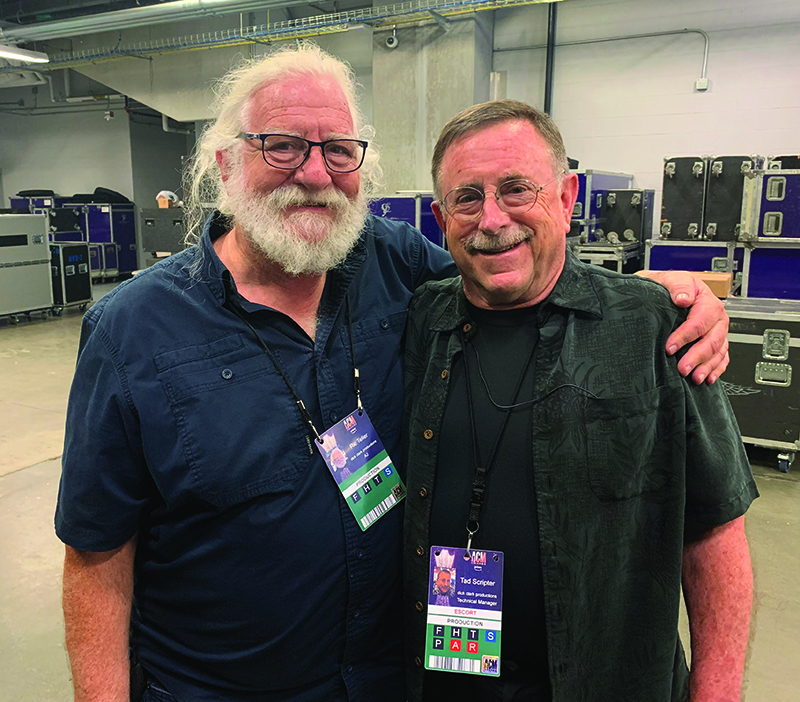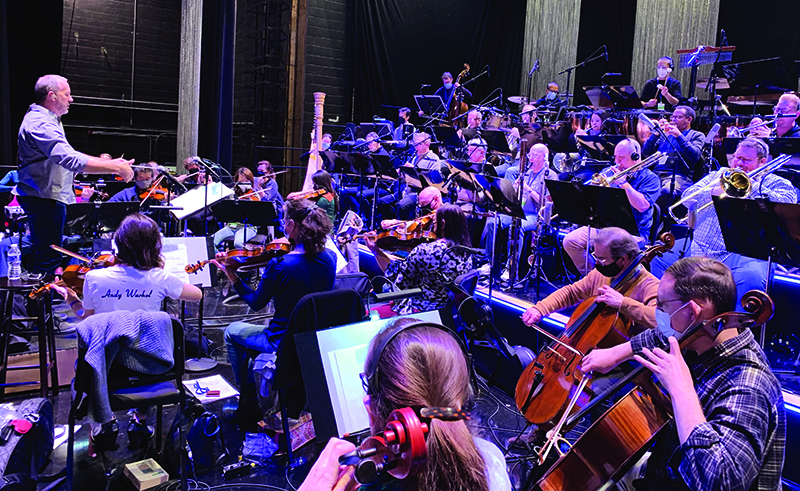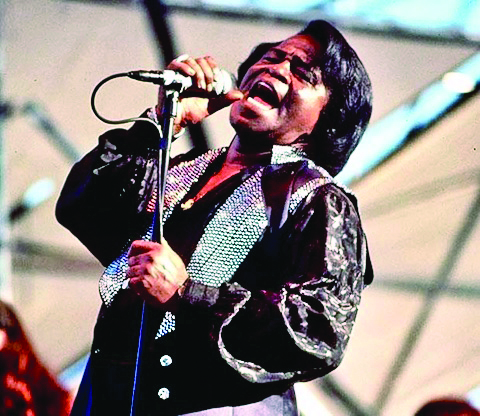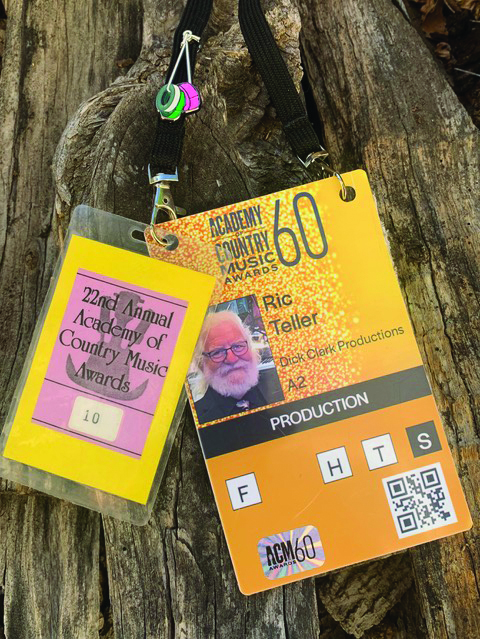
by Ric Teller
I’ll take the soup.
My grandpa Dave liked Mussorgsky, Tchaikovsky, and matzo ball soup. He wasn’t educated in music; in fact, he left school after the sixth grade to go to work, eventually running a men’s clothing store. For decades, many businessmen in Lincoln, Nebraska, dressed in suits from Clark’s Clothing. I have a vivid memory of him sitting on an ornate wooden chair in his living room, conducting the New York Philharmonic, the Chicago Symphony, or another esteemed orchestra while listening to them on television or an L.P. For those who have forgotten, L.P. is an analog sound storage and playback medium, a phonograph record with a speed of 331⁄3 rpm. The initials L.P. stand, of course, for Louie Prima.

In television, we don’t get too many opportunities to work with an orchestra. The ensemble at the Tony Awards in New York features Broadway show music, and at the Memorial Day and 4th of July holiday shows in D.C., the National Symphony performs familiar often patriotic tunes. My two regulars are the Oscars Orchestra, made up of an amazing group of studio musicians playing film music past and present. And the ensemble from the Kennedy Center Honors under the direction of Patrick Vaccariello. It is an accomplished group of players and many, including concertmaster Oleg Rylatko, come from the Kennedy Center Opera House Orchestra, the rest are “hired guns,” assembled by the talented music contractor Kimberlee Wertz. Each year, they perform a diverse and interesting variety of content based on the honorees. Ms. Wertz is the contractor for the Tonys, Oscars, and other shows as well. The Honors Orchestra sounds terrific, a combination of the hard work and professionalism of Patrick and the excellent musicians, combined with the skill of music mixer Paul Sandweiss. In addition to the orchestra, the Honors features an excellent house band, and often an additional ensemble or two. One small group in particular comes to mind. I can’t tell you the name of the honoree. Not because I’m sworn to silence and you don’t know the secret handshake, I just can’t remember. The mixer, Ed Greene, told us that one of the honors would include a piano quintet. Traditionally, the most common form of the piano quintet includes the piano (duh) and a standard string quartet, two violins, a viola, and there’s always room for a cello. I learned this and much more from Emanuel Wishnow at the University of Nebraska School of Music. Ed challenged me to make the mics as invisible as possible. The piano would be at full stick, and the string players made it clear that they did not want mics on their instruments. Inside the piano, I mounted two AKG414’s near the downstage wall of the case, hidden from the camera shot, one near the high strings near the hammers and the other about halfway down, near the lower strings. For the quartet, I taped two Countryman Isomax Hyper Cardioid mics with the heads at a 90-degree angle at the top of a plain black mic stand that hid well with the music stands used by the string players. Ed made it sound great. I loved when he would present a challenge like that. He is truly missed.
I’ve been very fortunate to work with a wide variety of extraordinary musicians over the years. One of the first big music shows that came my way starred Steve Allen, a very talented pianist, songwriter, humorist, and host. About forty years ago, we did six episodes of his program, Steve Allen’s Music Room at KTLA. I was tasked with mixing FOH and monitors on two linked 16-input Yamaha PM 1000’s. In addition to Steve hosting and playing, the show had a fantastic house band led by vibes player Terry Gibbs. The rest of the band was an all-star ensemble.
The stellar guest list included Jayne Meadows, Steve Lawrence, Eydie Gorme, Melba Moore, Joe Williams, Paul Williams, Henry Mancini, Dizzy Gillespie, Sarah Vaughn, Patti Page, Doc Severinsen, Ann Jillian, Burt Bacharach, Carole Bayer Sager, Anthony Newley, Rosemary Clooney, Lou Rawls, and Red Holloway. One more note: The show featured a little known twenty-seven-year-old announcer/sidekick, Bill Maher. All six of these programs are available on YouTube. Here is a link to number five, probably the best of the bunch. https://www.youtube.com/watch?v=u_IV5u3099A

JAMES BROWN! JAMES BROWN! JAMES BROWN! In 1991, James Brown and his band did a live concert for broadcast at The Wiltern Theatre. Now, for anybody my age, and you know who you are even if you don’t admit it, James Brown was a big deal. I remember the T.A.M.I. Show where James and the Famous Flames blew the doors off the place much to the chagrin of the Rolling Stones. So, getting to work with him on a live TV show was a huge treat. We were in the middle of rehearsal, the band was pumping and suddenly, James cut off the music. His band was well rehearsed and clearly knew how to follow directions. Then James turned and walked over to me. He spoke quickly but I got it. He turned and as he addressed some musical issue, one of his guys walked behind me and asked if I knew what he said. I answered in the affirmative. James thought the guitar amp had too much high end and was aimed too directly at his vocal mic. I rotated the offending amp just a little off-stage, covered it with a light cloth, and asked the guitar player if he would take a tiny bit of treble out of his amp. On the next pass, James turned and nodded, and his guy came back to say that it was good. Then I asked if I could learn the proper way to prepare his mic, cable, and stand. The prep, attaching the cable to the mic stand with wraps of electrical tape was important for an integral part of his performance. I did the mic preparation for that live show and several other James Brown performances proudly earning my J.B. Mic Prep merit badge.
Like many of you, The Music Man is one of my favorite Broadway musicals. Many years ago, when I was new to California and trying to become a trombone player with a pager, I got a call to play in the pit orchestra for a Beverly Hills summer stock theater run of that show. On opening night, an older man slowly made his way down the aisle to the orchestra and asked if he could sit in on the flute. He played the entire show. It was Meredith Willson. I played in the pit orchestra for The Music Man with Meredith Willson! The show revolves around a con man selling band instruments to the Iowa townsfolk. He plans to teach the boys in his band how to play using “the think system.” At the Emmys last September (congratulations to all the nominees and winners), I was having a lovely lunch with some even lovelier coworkers/friends when one, Joey Adelman, asked about an event that happened long ago. He wanted to know if a nearly forgotten story of an A2 misadventure was truth or legend. As the story goes, Murray Siegel, A2 Emeritus, and his accomplice, decided to set all the vocal mics for the live, three-hour American Music Awards by using “the think system.” They … um … we … put down no marks on the Shrine Auditorium stage. Needless to say, it was quite a challenge. Like The Music Man, in the end it turned out fine … well, except that we didn’t have a marching band. In hindsight, I guess it is both truth and legend.
I’ve mentioned my start at KTLA in many of these columns. Recently, I was in a discussion about retirement (as in, why don’t you stop working and let someone else have a turn), and the subject of institutional knowledge came up. Everyone has a different experience getting into our business and learning the craft. In the late 1970s, when I began, there were still a lot of staff jobs at the networks and independent TV stations. KTLA had more than one hundred engineers to keep the station on the air, tape the shows that were produced on their stages, and maintain all of the equipment. In 1979, twenty-five of those engineers had worked there for more than twenty-five years. The most senior engineers in that group started in the 1940s, the newest began in 1954. All worked with Klaus Landsberg. Even as a complete novice, the vast institutional knowledge affected me in a big way. I am not surprised when even today, I tap into some method or detail or process or even a phrase that I learned from those men like “pick up that sleeping beauty” IYKYO (If You Know, You’re Old). In short, the lessons I learned allowed me to begin a career that has lasted forty-five years. Of course, my education continued in the freelance world, especially when I joined the group doing specials and award shows. To this day, we continue to invent ways to make shows work. Usually, a product of aggregate knowledge and more than a little experimentation. Even now, I love to learn new ways, and when I see someone younger applying the tried-and-true methods, I think about the audio engineering DNA that made that happen. I wish I could let those KTLA teachers know how much they have contributed.

Last May, I had my picture made with fellow Local 695 forty-year pin holder, Tad Scripter, at the Academy of Country Music Awards, in Frisco, Texas. We captioned it: 95 years of television experience in three square feet. Broadcast TV has existed in Los Angeles for just under eighty years (yes, experimental stations started further back in time). Tad and I have participated in more than half of that history since the first station, KTLA, went on the air. Somewhere in my credential pile, one from the 22nd ACM’s at Knott’s Berry Farm is a mathematical reminder. We recently did the 60th. Man, it goes fast.
I am grateful to be able to write and share these memories, in some little way, it is my contribution to the institutional knowledge of making entertainment television. I’m sorry that I didn’t get to share any of these tales of musical adventures with grandpa Dave. It would have been great fun to sit him down in front of a live orchestra. I’m sure he would have conducted along. Then, we could have gone out for a bowl of soup.